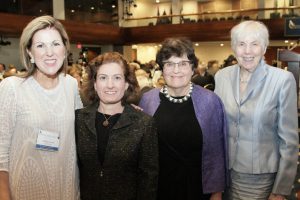Collaborative Triple Negative Breast Cancer Research
Enabled by Charitable Bequest Gift
Triple negative breast cancer (TNBC) accounts for about twenty percent of all breast cancers and is the deadliest form of the disease. Unlike most breast cancers, TNBCs do not respond to hormone therapies or HER-2 targeted therapy, leaving patients with limited treatment options.
Taxol® is one of the chemotherapy drugs used for treating TNBC. Unfortunately, patients with TNBC often do not respond to Taxol outright or relapse after initial response as resistance develops over time.
Susan Horwitz, Ph.D. is a world-renown molecular pharmacologist at Albert Einstein College of Medicine who studies how drugs work in the body. Dr. Horwitz first discovered how Taxol works inside cells to halt cell division. Her research has significantly contributed to the wide clinical application of Taxol—today, the drug has been used to treat more than a million patients worldwide for breast, ovarian and lung cancer among other cancer types.
Finding new anti-cancer treatments and approaches to stop resistance is Dr. Horwitz’ scientific passion. In her studies of Taxol and another drug called discodermolide, Dr. Horwitz found that the two drugs bind to the same cancer targets inside the cell but in different, complementary ways—this could provide a unique opportunity for developing new anti-tumor drugs that are more effective than Taxol.
Prompted by this intriguing idea, Dr. Horwitz brought her data to organic chemist Dr. Amos Smith, III, at the University of Pennsylvania. A brilliant, cross-disciplinary research collaboration was thus born.
Dr. Horwitz and Dr. Smith decided to prepare a small library of hybrid molecules containing segments of both Taxol® and discodermolide—a hybrid molecule could have an increased affinity to the cancer targets and reduced risk of drug resistance as well as toxicity for patients.
Dr. Smith synthesized several lead hybrid Taxol discodermolide molecules. Dr. Horwitz evaluated the compounds and some worked as good or better than either parent molecule, but not extraordinarily better. As often it goes in research, after carefully analyzing the data, the scientists decided to open another door — making chemical changes to only discodermolide.
With their combined expertise in studying discodermolide for many years, Dr. Horwitz and Dr. Smith believe that this molecule has the backbone structure to reduce the risk of drug resistance to Taxol. Discodermolide had previously treated cancer patients in an early Phase I clinical trial and was discontinued after some toxicity developed. Based on knowledge from his vast research in synthesizing analogues of discodermolide, Dr. Smith knew which substituents were the likely culprits that caused the associated toxicity. His team now began to synthesize discodermolide analogues with further refinement to reduce or eliminate the adverse side effects.
The lead discodermolide analogues effectively show major anti-tumor effects in TNBC and ovarian cancer cell lines. Excitingly and of high significance, the top analogue has very strong anti-tumor effects in a complex tumor model with much lower toxicity compared to discodermolide – the mother molecule. The experiments continue with this lead analogue and with others that are being synthesized.
The new door is open and this dynamic collaborative team is passionately pursing their new idea. Discodermolide analogues hold promise to overcome resistance to Taxol, providing more effective treatment for patients with TNBC.
Besides breast cancer, Taxol is also widely used for treating patients with ovarian and lung cancer. The new analogues developed by Drs. Horwitz and Smith will hopefully improve the treatment of these cancers as well.
Leaving a Legacy to the Future
The collaborative work of Dr. Horwitz and Dr. Smith was made possible by the NFCR Triple Negative Breast Cancer Research Grant, established with a generous legacy gift from the Marilyn Hill Estate. Ms. Hills’ Estate Trustees—Harriet Naschek, Stefanie Smith and Alan Phillipson—worked extensively with NFCR’s Donor Relations team, enabling a new and dynamic research collaboration to find effective treatments for triple negative breast cancer (TNBC), the most lethal type of breast cancer.
“We are truly grateful that NFCR listened so very closely to the background and objectives for this donation,” said Trustee Stefanie Smith. “In every possible way, NFCR has been dedicated to making this project truly matter not only today, but as a forward-looking and pivotal example of scientific innovation and collaboration.”











